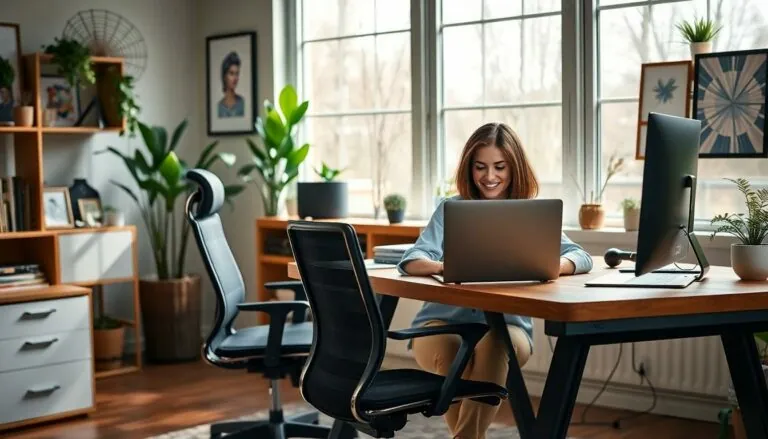Table of Contents
ToggleIn a world where working from home has become the norm, the quest for a green home office is more relevant than ever. Imagine swapping that bland cubicle vibe for a vibrant workspace that not only boosts productivity but also helps save the planet. Who knew that going green could be so chic?
From energy-efficient gadgets to sustainable decor, creating an eco-friendly workspace is easier than it sounds. It’s time to ditch the plastic and embrace plants that won’t just sit there looking pretty—they’ll actually improve air quality! So grab your favorite mug, put on your best “I’m saving the world” face, and let’s dive into the delightful world of green home offices that’ll make Mother Nature proud and your coworkers a tad jealous.
Benefits Of A Green Home Office
Creating a green home office offers numerous benefits, both environmentally and personally. Enhancing one’s workspace in an eco-friendly manner promotes sustainability and supports well-being.
Environmental Impact
A green home office significantly reduces carbon footprints. Using energy-efficient gadgets lowers energy consumption, conserves resources, and ultimately decreases greenhouse gas emissions. Incorporating sustainable materials in furniture and decor promotes responsible sourcing practices. Additionally, choosing plants for decoration not only beautifies but also aids in absorbing CO2 from the atmosphere, improving the air quality indoors. Opting for recycled materials in office supplies decreases landfill waste and encourages recycling trends. Small adjustments can lead to a positive environmental ripple effect.
Health Benefits
Health improvements often arise from a green home office. Plants indoors can enhance air quality, filter toxins, and promote better respiratory health. Natural light exposure boosts vitamin D levels, which can improve mood and increase productivity. Implementing ergonomic furniture reduces physical strain, leading to comfort during long work hours. Green spaces also create a calming effect, reducing stress and enhancing mental clarity. Sustainable practices in the workspace contribute to overall well-being, fostering a healthier lifestyle while working from home.
Key Elements Of A Green Home Office

Creating a green home office involves several key elements that promote sustainability while enhancing productivity.
Energy Efficiency
Energy-efficient devices significantly lower electricity usage. Opt for LED lighting, which consumes up to 80% less energy than traditional bulbs. Consider power strips with timers or smart plugs to prevent phantom energy loss. Efficient appliances also contribute to energy savings, so choose Energy Star-rated products. Maintaining the right temperature with programmable thermostats increases comfort and further reduces energy consumption. Implementing these strategies helps create a more sustainable workspace.
Sustainable Materials
Sustainable materials play a crucial role in eco-friendly office design. Furniture made from reclaimed wood minimizes environmental impact while adding character to the workspace. Bamboo products often replace conventional wood items due to their rapid growth and renewability. Additionally, using recycled materials for office supplies cuts down on waste. Opting for non-toxic paints and finishes ensures a healthier environment. These choices reflect a commitment to sustainability and enhance the overall aesthetic.
Indoor Air Quality
Indoor air quality significantly benefits from incorporating plants into the workspace. Plants, such as snake plants and peace lilies, filter airborne toxins and improve oxygen levels. Additionally, maintaining proper ventilation allows for fresh air circulation, contributing to a healthier atmosphere. Regularly cleaning surfaces helps minimize dust and allergens. Non-toxic furnishings and decor reduce chemical emissions, creating a safer environment. Prioritizing these factors promotes well-being and productivity in a green home office.
Tips For Creating A Green Home Office
Crafting an eco-friendly workspace enhances both productivity and environmental impact. Implementing the following tips promotes a sustainable atmosphere in the home office.
Eco-Friendly Furniture
Selecting furniture made from sustainable materials is crucial. Reclaimed wood offers a rustic charm while minimizing deforestation impacts. Bamboo, known for its rapid growth, serves as a strong and durable choice. Opting for furniture certified by organizations like the Forest Stewardship Council ensures responsible sourcing. Purchasing from local artisans can also reduce transportation emissions and support the community. Prioritizing multi-functional furniture helps maximize space and resource efficiency, minimizing the need for excess items.
Natural Lighting
Utilizing natural light significantly improves energy efficiency. Positioning the desk near windows allows sunlight to illuminate the workspace, reducing reliance on artificial lighting. Installing sheer curtains or blinds enhances control over light levels while maintaining privacy. Exposure to daylight contributes positively to mood and focus, fostering a healthier working environment. Incorporating mirrors can help reflect light, brightening dim areas. For areas with limited natural light, consider LED lights that mimic daylight to maintain productivity levels.
Waste Reduction Practices
Implementing waste reduction strategies maintains an eco-conscious workspace. Transitioning to digital documents limits paper use and storage needs. Using recycled printer paper and supplies reinforces committed practices towards sustainability. Regularly assessing office items for unnecessary disposables promotes mindful consumption. Creating a compost system for organic waste enhances recycling efforts and provides nutrients for home plants. Donating unneeded supplies further minimizes waste while helping others, exemplifying responsible resource management.
Technology For A Green Home Office
Integrating technology into a green home office enhances energy efficiency and reduces environmental impact. This section explores essential tech options that contribute to sustainable workspaces.
Energy-Efficient Devices
Energy-efficient devices significantly lower electricity consumption. Switching to LED lighting, for instance, consumes up to 75% less energy than traditional bulbs while lasting 25 times longer. Utilizing Energy Star-rated appliances, such as printers and computers, cuts energy use by 30% to 50%. Investing in smart power strips also prevents phantom energy drain, automatically shutting off power to devices that aren’t in use. Overall, these devices support a more eco-friendly workspace, helping create a healthier environment.
Smart Home Solutions
Smart home solutions optimize energy usage and enhance convenience. Smart thermostats regulate heating and cooling, potentially reducing energy bills by 10% to 15%. Integrating voice assistants allows for hands-free control of various devices, minimizing unnecessary energy use. Automated lighting systems adjust brightness based on natural light levels, promoting energy savings. Furthermore, apps that monitor energy consumption provide insights into usage patterns, encouraging more sustainable habits. These technologies foster an efficient, environmentally conscious home office.
Creating a green home office is more than just a trend; it’s a commitment to a sustainable future. By incorporating eco-friendly practices and materials, individuals can enhance their work environment while making a positive impact on the planet. The benefits extend beyond aesthetics, improving health and productivity through better air quality and ergonomic design.
With simple changes like using energy-efficient devices and adding plants, anyone can transform their workspace into a haven of sustainability. Embracing this lifestyle not only fosters personal well-being but also contributes to a collective effort toward environmental responsibility. The journey to a greener workspace is rewarding and essential in today’s world.







